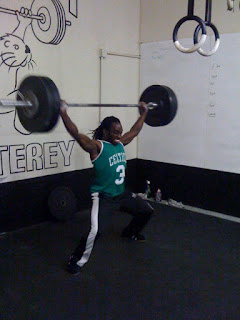 We like weighing and measuring our food. Not necessarily the Zone: we like weighing and measuring our food.
We like weighing and measuring our food. Not necessarily the Zone: we like weighing and measuring our food.The Zone is 30% protein/30% fat/40% carbohydrate. By Barry Sears' own admission, this is merely a ratio that sits at the top of the bell curve. It's a good starting point, but it won't work for everyone. Robb Wolf said it best: "there is no magic ratio."
But we still like weighing and measuring. Not necessarily the Zone: weighing and measuring.
Lately it seems weighing and measuring and The Zone are perceived as one and the same. But Barry Sears didn't invent weighing and measuring. He invented the block method, which is our favorite thing about the Zone: it makes it a whole lot easier to weigh and measure our food. Blocks are easier than grams, particularly for those of us who are not so mathematically inclined (i.e., Jacob.)
We're big fans of Paleo eating. Quality is important. We see Paleo as the nutritional equivalent of the deadlift, squat, clean & jerk, running, pullup, etc...high quality movements that you need to be performing. But you want to know how much weight is on the bar, how long it took you to run 400m, or how many pullups you did, right?
Nutrition is no different. In order to achieve optimal output, we've got to measure the input, and then adjust accordingly.
Should you weigh and measure every meal every day forever? In a perfect world, yes. But it most likely won't happen, and that's fine. People are too busy, and except for the occasional super Type-A individual, the benefit of having every meal perfectly weighed and measured is not equal to the cost. The suggestion I usually offer to my athletes is this: When starting, weigh and measure for one month. After that, weigh and measure one or two meals each day to keep your "calibration." This allows you to weigh and measure the meals you eat when you're at home and have time to be precise without stressing out.
Once you're used to weighing and measuring, it's time to tweak. Play with lower carbs/higher fat, post WOD nutrition strategies, etc. Record the results, and with time, you'll find your optimal ratio.
If you can't seem to get it just right, don't fear. There are professionals who can do it for you at a pretty reasonable price. I'm doing this now, with Steve from Primitive Foods (who I stole this posts picture from, by the way.)
Post thoughts to comments. If you have recommendations for other meal planning services you've had a positive experience with, post those to comments as well.



